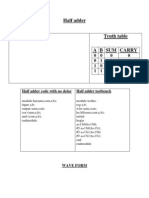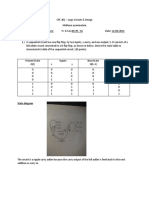Lab 5 - Combinational Logic Modules - Adders and Subtractors
Uploaded by
Siegrique Ceasar A. JalwinLab 5 - Combinational Logic Modules - Adders and Subtractors
Uploaded by
Siegrique Ceasar A. JalwinCPE 301 – Logic Circuit
Experiment 5: Combinational Logic Modules – Adders and Subtractors
Objective/s:
1. To describe the difference between combinational and sequential logic circuits.
2. To describe the operation and the construction of binary adders and subtractors
3. To design a hierarchical combinational circuit and simulate it using Logisim.
Equipment Required
1. Software simulation: The Logisim software package
Theory
1. Combinational vs Sequential Circuits
Digital logic circuits can be classified into two main types: combinational and sequential. A
combinational circuit is a logic circuit that is made up of combinations of logic gates. The application
of inputs into combinational circuits generates the output instantaneously. Some examples of
typical combinational circuits are binary adders, subtractors, comparators, decoders, encoders,
multiplexers, and demultiplexers. All these digital components will be covered and discussed
practically starting from this lab.
A sequential circuit, on the other hand, is made up of a combinational circuit and memory elements,
called flip-flops. The outputs of the sequential circuits depend not only on the inputs but also on the
output of the memory elements. Some examples of sequential circuits are counters and shift
registers.
Procedures/Lab Work:
1. Hierarchical Design
Hierarchical design is a design technique in which pre-designed modules are used to build larger
ones. In this lab, you will hierarchically build the full adder using half adders. The full adder will then
be used to build a larger adder-subtractor circuit. Historically, in the field of digital design, Small
Scale Integrated circuits (SSI) are used to build Medium Scale Integrated circuits (MSI), which in turn
are used to build Large Scale Integrated circuits (LSI). LSI modules are finally used to build Very Large
Scale Integrated circuits (VLSI) and Ultra Large Scale Integrated circuits (ULSI).
2. Binary Adders and Subtractors
Binary adders and subtractors are combinational circuits that can perform the operations of
Prepared by: Rodolfo G. Doromal, Jr. Ph.D. Page 1
addition and subtraction of binary numbers, respectively. In this lab, we will study and construct
various adder and subtractor circuits.
a) Half Adder (HA) Circuit
The combinational circuit that adds only two bits is called half adder.
Since there are two inputs (x and y), only four possible combinations of inputs can be applied. These
four possibilities, and their resulting Sum (S) and Carry (C) are shown in following truth table.
From the truth table, we could get the Boolean expression of C and S as
Accordingly, the logic circuit of the half adder is drawn below.
b) Full Adder (FA) Circuit
Full Adder (FA) is a combinational circuit that adds three bits. It generates two outputs: Sum (S) and
carry (C). Full adders allow for the addition of multi-bit numbers. A Designer just needs to provide a
way for carries to propagate between bit positions.
The truth table of the full adder is as follow.
From the truth table, we could get the Boolean expression of Cout and S as
Prepared by: Rodolfo G. Doromal, Jr. Ph.D. Page 2
Accordingly, the logic circuit of the full adder is drawn below.
The previous figure also shows that the full adder could be built using half adders. By comparing the
full adder circuit to the half adder one, you could simply implement the full adder circuit using half
adders as follow
c) Adder-Subtractor Circuit
The subtraction of two binary numbers can be done by taking the 2’s complement of the subtrahend
and adding it to the minued. The 2’s complement can be obtained by taking the 1’s complement (i.e.,
inverting all the bits) and adding 1. For example, to perform A – B, we complement the four bits of B,
add them to their corresponding four bits of A, and add 1. The simplest way to add a binary 1 is to insert
it through the input carry.
An XOR gate could be used as an inverter if we place logic 1 at one of the inputs. This helps in getting
the 1’s complement of the subtrahend. Then, we add 1 to get the 2’s complement. The 2's complement
is finally added to the minued to get the final result of the subtraction.
The following figure shows the adder-subtractor circuit. The mode input M controls the operation.
When M=0, the circuit is an adder. Whereas, when M=1, the circuit becomes a subtractor. Although the
figure is for only four bits, this circuit can be cascaded for any number of inputs.
Note: During subtraction, if A ≥ B, the result is a positive number and the output carry is equal to 1. If
A < B, the subtraction gives a negative difference represented in the 2’s complement format and the
output carry is equal to 0. Therefore, during subtraction, the carry actually represents the inversion of
the borrow.
Prepared by: Rodolfo G. Doromal, Jr. Ph.D. Page 3
3. Software Simulation
a. Designing a Half Adder using Basic Gates
1. Login into one of the PCs in the lab using your user name and password.
2. Double click on the logisim-win-2.7.1 icon on the desktop of the computer. Logisim will
be launched and a new project would be created for you.
3. Save the project by clicking Ctrl+S. The Save window will appear. As you will do
hierarchical design in this lab, the project should take the name of the top level.
Therefore, enter Adder subtractor in the File name and click Save.
4. Now, let's start to design the most inner module, the Half Adder (HA). From the project
menu, click on Add Circuit.
5. The Input Circuit Name window will appear. Enter HA as the name of the circuit and
click OK
6. A new module named HA is created for you and added to the explorer pane. The
magnifying glass over the HA indicates that it is the module that is currently viewed on
the canvas.
Prepared by: Rodolfo G. Doromal, Jr. Ph.D. Page 4
7. Enter the circuit of the half adder.
8. Check the operation of the HA module, either by using the poke tool or the
combinational analysis window. The truth table should agree with the half-adder.
9. Before using the half adder hierarchically in larger designs, let's adjust it appearance
first. From the project menu, click on Edit Circuit Appearance.
Prepared by: Rodolfo G. Doromal, Jr. Ph.D. Page 5
10. The module of the half adder will appear as a rectangle with two inputs and two
outputs.
11. Enlarge the module and move input and output ports to proper locations
12. From the toolbar, click on the Add text button ( ). Then, click beside the two inputs and
name them x and y. Similarly, name the two outputs S and C, as shown below.
Prepared by: Rodolfo G. Doromal, Jr. Ph.D. Page 6
13. Finally, click on the HA module on the explorer pane. Then, in the attribute table, write
HA beside the Shared Label attribute. This would be the name of the module when used
in larger designs. Also, change the Shared Label Facing attribute to North.
14. You are completely done with the half adder. You are ready to use it to build the full
adder circuit. Before doing that, remember to save your work by clicking Ctrl+S.
b. Designing a Full Adder using Half Adders
1. From the Project menu, click on Add Circuit. In the Input Circuit Name window, name
the new circuit FA and click OK.
2. The new module is created for you in the explorer pane and an empty sheet is opened
in thecanvas for it.
3. Now, let's build the FA using two HAs, as discussed.
4. From the explorer pane, click on the HA module and insert two of them into the canvas.
5. From the toolbar, click on the OR gate button and insert one of it into the canvas.
Change the Number of Inputs attribute to 2.
6. Wire the circuit, according to the circuit diagram as shown below.
Prepared by: Rodolfo G. Doromal, Jr. Ph.D. Page 7
7. Check the operation of the FA module, either by using the poke tool or the combinational
analysis window.
8. Edit and adjust the appearance of the FA module.
9. Now, you successfully build the FA using HAs. Remember to save your work before
hierarchically use the FA to build the adder subtractor circuit.
c. Designing an Adder Subtractor using Half Adders and XORs
1. Now, we reach the top level module, the adder subtractor. Therefore, in the explorer
pane, double click on the main file.
2. Use four FAs and four XORs to build the adder subtractor circuit, as discussed.
Prepared by: Rodolfo G. Doromal, Jr. Ph.D. Page 8
3. To understand the benefit and the power of using the hierarchical design technique.
Imagine building the adder subtractor circuit using the traditional method of building
the truth table and minimizing the logic expression of the outputs. The 9-input truth
table would have 512 rows and the logic expression of the output would be very hard to
minimize. In order to visualize this complexity, use the combinational analysis window
to see the truth table and the logic expressions of the output. The following figure gives
an example of the logic expression for C4.
4. Use the poke tool to simulate your circuit. Apply to following values though A's and B's
and record their corresponding values of S's and C4. Interpret your results (i.e., Explain
why S and C have these values). Have you TA to check your work.
5. Now, let's use another convenient method when dealing with multiple related bits, like
A's, B's and S's. A common practice in the digital logic field is to combine these bits in a
wire bundle,called the bus. So, let's see how we could create these busses in Logisim.
6. From the Wiring folder in the explorer pane, click on Splitter and insert it into the
canvas.
7. The splitter you just inserted will be used to create the bus of input A. Input A has four
bits, A3A2A1A0. Therefore, in the attribute table, change the Bit Width In attribute to 4.
Prepared by: Rodolfo G. Doromal, Jr. Ph.D. Page 9
Similarly, change the Fan Out attribute to 4 (i.e., the splitter would split the 4-bit bus
into 4 separate wires)
8. From the toolbar, insert an input pin. In the attribute table, label it as A and change its
Data Bits attribute to 4.
9. The input pin should have extended in the canvas to have 4 bits.
10. Wire the new 4-bit port, A, to the left side of the splitter.
11. Remove the old input pin, A0, and wire bit 0 (i.e., the top right bit) of the splitter instead
of it.
Prepared by: Rodolfo G. Doromal, Jr. Ph.D. Page 10
12. Repeat step 4.5.3.11 to remove input pins A1, A2, and A3 and connect bit 1, bit 2, and
bit 3 of the splitter instead of them.
13. Finally, insert two more splitters for bus B and Bus S. Your final circuit
should appear as follow.
14. Use the poke tool to practice simulating your final circuit and fill in the following table
again.
Prepared by: Rodolfo G. Doromal, Jr. Ph.D. Page 11
Questions/Exercises:
1. Design a 4-bit binary decrementer circuit using four half adders. Simulate the circuit using Logisim to
ensure that it works properly. Include your design and snapshots from Logisim to your report.
Reference(s)
1. Introduction to Logic Circuits & Logic Design with Verilog, 1st Edition, Brock J. LaMeres
2. Digital Design, 3rd Edition, M. Morris Mano
3. Digital Principles and Logic Design, A. Saba & N Manna
Laboratory Report Format
CPE 306 – Introduction to HDL
Name: _____________________________________ Yr. & Sec. ____________ Date: ______________
Experiment Title
Experiment No. _
I. Introduction
II. Objectives
III. Materials and Components
IV. Procedure (include screenshots/images)
Prepared by: Rodolfo G. Doromal, Jr. Ph.D. Page 12
V. Results and Discussion
VI. Conclusion
Prepared by: Rodolfo G. Doromal, Jr. Ph.D. Page 13
You might also like
- TM352 TMA SP 23 - 24 Riyadh Ahmed 21412393No ratings yetTM352 TMA SP 23 - 24 Riyadh Ahmed 2141239320 pages
- ITP For Installation & Leakage Test For HVAC Ducts and AccessoriesNo ratings yetITP For Installation & Leakage Test For HVAC Ducts and Accessories1 page
- ECE 424FL - Feedback and Control Systems Laboratory - RevisedNo ratings yetECE 424FL - Feedback and Control Systems Laboratory - Revised7 pages
- Experiment No. (2) Optical Sources: ObjectNo ratings yetExperiment No. (2) Optical Sources: Object4 pages
- Logic Families: Ics, Logical Operation Operational PropertiesNo ratings yetLogic Families: Ics, Logical Operation Operational Properties33 pages
- Half and Full Adder Implementation in Verilog (DSD)No ratings yetHalf and Full Adder Implementation in Verilog (DSD)8 pages
- Unit I Classification of Signals and SystemsNo ratings yetUnit I Classification of Signals and Systems13 pages
- Activity No.1 Setting Up and Programming ControllersNo ratings yetActivity No.1 Setting Up and Programming Controllers13 pages
- Experiment 22 - Undersampling in SDR (Software Defined Radio)No ratings yetExperiment 22 - Undersampling in SDR (Software Defined Radio)12 pages
- Single Phase Full Wave Voltage Multiplier PDF0% (1)Single Phase Full Wave Voltage Multiplier PDF3 pages
- 9-Frequency Spectrum, Power relation-17-Dec-2019Material - I - 17-Dec-2019 - Extract - Pages - From - 2 PDFNo ratings yet9-Frequency Spectrum, Power relation-17-Dec-2019Material - I - 17-Dec-2019 - Extract - Pages - From - 2 PDF10 pages
- Lab No.3 Discrete Time Systems in Time Domain Impulse Response of Lti SystemNo ratings yetLab No.3 Discrete Time Systems in Time Domain Impulse Response of Lti System5 pages
- 5-S MATRIX PROPERTIES PROOF SIGNAL FLOW GRAPH-17-Jul-2019Material - I - 17-Jul-2019 - Lect3-S - Matrix - Proof - Numerical - Problem100% (1)5-S MATRIX PROPERTIES PROOF SIGNAL FLOW GRAPH-17-Jul-2019Material - I - 17-Jul-2019 - Lect3-S - Matrix - Proof - Numerical - Problem87 pages
- Tutorial 02 Ele 290 - Power Ac Circuits - QuestionNo ratings yetTutorial 02 Ele 290 - Power Ac Circuits - Question5 pages
- EC1356-VLSI Design Lab Manual EC1405 - VLSI Lab ManualNo ratings yetEC1356-VLSI Design Lab Manual EC1405 - VLSI Lab Manual44 pages
- Lab 6 - Combinational Logic Modules - DecodersNo ratings yetLab 6 - Combinational Logic Modules - Decoders7 pages
- Digital Design BEC30503 Instruction Sheet: Lab No. Lab Title Semester Session Lab Durations Independent StudiesNo ratings yetDigital Design BEC30503 Instruction Sheet: Lab No. Lab Title Semester Session Lab Durations Independent Studies30 pages
- Index: To Simulate The Common Bus Using MultiplexersNo ratings yetIndex: To Simulate The Common Bus Using Multiplexers20 pages
- Lab 9 Layout of 1-Bit Full Adder: by Sachin B. Kadam 15ECE1022No ratings yetLab 9 Layout of 1-Bit Full Adder: by Sachin B. Kadam 15ECE102214 pages
- Tda2003 Stereo Bridged Amplifier: Schematic To PCB Design: in Partial Fulfillment of The Requirements inNo ratings yetTda2003 Stereo Bridged Amplifier: Schematic To PCB Design: in Partial Fulfillment of The Requirements in7 pages
- Lab 4 - NOR and NAND Implementation of Logic FunctionsNo ratings yetLab 4 - NOR and NAND Implementation of Logic Functions9 pages
- Identifying Objects Using RF Transmitters and Receivers, and Retrieving DataNo ratings yetIdentifying Objects Using RF Transmitters and Receivers, and Retrieving Data6 pages
- Hyundai Service Guide Diesel and LPG 7 Range100% (42)Hyundai Service Guide Diesel and LPG 7 Range10 pages
- Project Name: IC Engine Simulation: Pankaj Dohale (202180028) Project byNo ratings yetProject Name: IC Engine Simulation: Pankaj Dohale (202180028) Project by10 pages
- MX2 Training Program 12 Encoded Inspections100% (1)MX2 Training Program 12 Encoded Inspections22 pages
- MC IPMClearingFormatErrorNumbersandMessagesNo ratings yetMC IPMClearingFormatErrorNumbersandMessages440 pages
- Fly The Maddog X Operations Manual Volume 2No ratings yetFly The Maddog X Operations Manual Volume 2177 pages
- ITP For Installation & Leakage Test For HVAC Ducts and AccessoriesITP For Installation & Leakage Test For HVAC Ducts and Accessories
- ECE 424FL - Feedback and Control Systems Laboratory - RevisedECE 424FL - Feedback and Control Systems Laboratory - Revised
- Logic Families: Ics, Logical Operation Operational PropertiesLogic Families: Ics, Logical Operation Operational Properties
- Half and Full Adder Implementation in Verilog (DSD)Half and Full Adder Implementation in Verilog (DSD)
- Activity No.1 Setting Up and Programming ControllersActivity No.1 Setting Up and Programming Controllers
- Experiment 22 - Undersampling in SDR (Software Defined Radio)Experiment 22 - Undersampling in SDR (Software Defined Radio)
- 9-Frequency Spectrum, Power relation-17-Dec-2019Material - I - 17-Dec-2019 - Extract - Pages - From - 2 PDF9-Frequency Spectrum, Power relation-17-Dec-2019Material - I - 17-Dec-2019 - Extract - Pages - From - 2 PDF
- Lab No.3 Discrete Time Systems in Time Domain Impulse Response of Lti SystemLab No.3 Discrete Time Systems in Time Domain Impulse Response of Lti System
- 5-S MATRIX PROPERTIES PROOF SIGNAL FLOW GRAPH-17-Jul-2019Material - I - 17-Jul-2019 - Lect3-S - Matrix - Proof - Numerical - Problem5-S MATRIX PROPERTIES PROOF SIGNAL FLOW GRAPH-17-Jul-2019Material - I - 17-Jul-2019 - Lect3-S - Matrix - Proof - Numerical - Problem
- Tutorial 02 Ele 290 - Power Ac Circuits - QuestionTutorial 02 Ele 290 - Power Ac Circuits - Question
- EC1356-VLSI Design Lab Manual EC1405 - VLSI Lab ManualEC1356-VLSI Design Lab Manual EC1405 - VLSI Lab Manual
- Digital Design BEC30503 Instruction Sheet: Lab No. Lab Title Semester Session Lab Durations Independent StudiesDigital Design BEC30503 Instruction Sheet: Lab No. Lab Title Semester Session Lab Durations Independent Studies
- Index: To Simulate The Common Bus Using MultiplexersIndex: To Simulate The Common Bus Using Multiplexers
- Lab 9 Layout of 1-Bit Full Adder: by Sachin B. Kadam 15ECE1022Lab 9 Layout of 1-Bit Full Adder: by Sachin B. Kadam 15ECE1022
- Right Way to Build Half and Full Adders with Logic GatesFrom EverandRight Way to Build Half and Full Adders with Logic Gates
- Tda2003 Stereo Bridged Amplifier: Schematic To PCB Design: in Partial Fulfillment of The Requirements inTda2003 Stereo Bridged Amplifier: Schematic To PCB Design: in Partial Fulfillment of The Requirements in
- Lab 4 - NOR and NAND Implementation of Logic FunctionsLab 4 - NOR and NAND Implementation of Logic Functions
- Identifying Objects Using RF Transmitters and Receivers, and Retrieving DataIdentifying Objects Using RF Transmitters and Receivers, and Retrieving Data
- Project Name: IC Engine Simulation: Pankaj Dohale (202180028) Project byProject Name: IC Engine Simulation: Pankaj Dohale (202180028) Project by



































































































